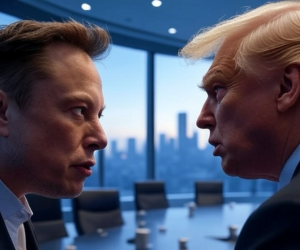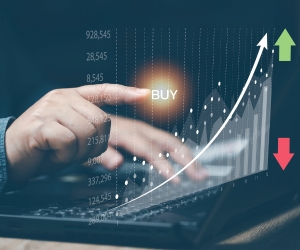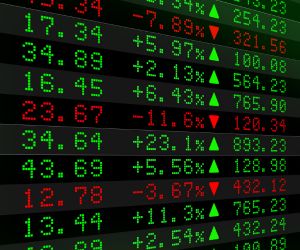Tesla's stock experienced a sharp 14.3% drop on June 5, 2025, reducing its market capitalization by $152 billion following a public conflict between Elon Musk and Donald Trump. This drop deepens a volatile trend that had already been forming since the beginning of the year. The first-quarter financial results were disappointing, public perception of Musk has fluctuated depending on his political role, and tariff policies complicate the outlook. Despite some isolated rebounds, the current regulatory and political environment adds uncertainty about Tesla's future.

Decline in Deliveries and Financial Results
Tesla began 2025 with troubling signs. In the first quarter of the year, it reported a 13% drop in vehicle deliveries, with 337,000 units sold, marking the worst year-over-year contraction in its history.
Quarterly revenues were $19.34 billion, below the $21.4 billion the market anticipated, and the earnings per share (EPS) stood at $0.27 against the estimated $0.42. These negative results translated into a decrease in confidence from institutional and retail investors.
Immediate Market Impact
The effect was immediate: double-digit declines in the stock price, reduced favorable coverage from analysts, and a reevaluation of the multiples that investors are willing to pay for Tesla's future growth.
The decline in sales coincides with a global slowdown in demand for electric vehicles.
Competition from Chinese manufacturers and tax incentives in other countries have eroded Tesla's market share.
The company did not meet its gross margin targets, affecting the sustainability of its business model.
Macroeconomic uncertainty and high interest rates are impacting large-scale consumer decisions.
Nonetheless, many investors see Tesla as a resilient company due to its focus on innovation, especially in the field of autonomous driving.
Musk-Trump Dispute and Stock Market Crash
June 5, 2025, marked a negative milestone for Tesla. Its shares fell 14.3% following a public feud between Elon Musk and Donald Trump, marking the worst trading day for the company since March of this same year. The dispute began when Musk called Trump's proposed new tax and spending package, known as "One Big Beautiful Bill," a "repugnant abomination."
Trump countered by stating he would eliminate government subsidies and contracts granted to Musk's companies, which would directly affect the $20 billion in contracts SpaceX has received since 2008. Musk responded with personal accusations, stating that without him, Trump wouldn’t have won the election, and suggested links between Trump and Jeffrey Epstein.
Immediate and Prolonged Consequences
Tesla's shares fell as much as 18% during the session, closing at $249.35.
Tesla's market capitalization was reduced to $916 billion, losing its "trillionaire" status.
Musk lost $34 billion in personal wealth, according to Bloomberg.
Analysts fear new adverse regulations, including possible technical requirements incompatible with FSD technology.
Furthermore, the risk of losing institutional backing and the elimination of tax credits for electric vehicles exacerbates the situation. Investors cautiously watch how the relationship between Musk and the US government evolves, fearing broader consequences for Tesla and SpaceX.
Signs of Recovery and Future Projections
Despite episodes of sharp correction, Tesla has shown resilience in previous months. In October 2024, its shares rose 19% in a single day after presenting better-than-expected quarterly results, generating optimism about the projected 20–30% growth for 2025.
More recently, a 10% rebound was attributed to enthusiasm for the evolution of Full Self-Driving (FSD) software and signs of easing in trade policy. However, the dispute with Trump has stalled that momentum, raising new questions about the future of regulatory and financial support.
Analysts' Perspective
Alexander Potter (Piper Sandler) maintains an optimistic view with a price target 90% higher, based on FSD and new factories.
JPMorgan is more cautious, citing the global demand drop and regulatory risks as main obstacles.
Estimates for 2026 range between $174.23 and $323.00, depending on macro and political variables.
In extreme scenarios, a potential of up to $1,000 per share is speculated for 2030 if Tesla manages to dominate the AI transportation market.
Tesla faces an increasingly challenging environment where political, technological, and economic elements intertwine. Its ability to navigate these uncertain waters will determine if it can continue to be the disruptive leader it has been so far.
Steps to Invest in Tesla
Research and Analysis:
Tesla is the global leader in the electric vehicle and renewable energy market. Its core business includes selling electric cars like the Model S, Model 3, Model X, Model Y, Cybertruck, and Semi, as well as developing batteries, solar panels, and autonomous driving software (Full Self-Driving - FSD). Tesla is a highly volatile stock, driven by technological innovation and the leadership of its CEO, Elon Musk. Before investing, review its production capacity, profit margins, the adoption of electric vehicles, and competition from brands like Rivian, Lucid, BYD, and Volkswagen.Opening an Investment Account:
Tesla is listed on the Nasdaq under the ticker TSLA. To buy shares, open an account with a brokerage firm that provides access to US markets. Consider platforms with low commissions and access to fractional shares if you're looking to invest with a smaller initial capital. Typically, you'll need to provide some identification and proof of address. Compare the fees, trading platforms, and services offered by each brokerage to choose the one that best suits your needs.Define Your Investment Strategy:
Tesla is a high-growth stock but with significant volatility. It can be attractive to long-term investors who believe in the expansion of the electric vehicle sector, as well as to short-term traders looking to take advantage of its large price fluctuations. Consider investment strategies like buy & hold, swing trading, or day trading during times of high volatility.Execution and Monitoring:
Tesla reports quarterly financial results that can lead to significant price movements. Pay attention to data such as production, vehicle deliveries, profit margins, and development of new technologies. Also, follow the progress of the Gigafactories, expansion in key markets like China, and advancements in its autonomous driving technology.Portfolio Diversification:
Although Tesla is an innovative company, investing solely in it poses a high risk. Complement your investment with other tech stocks like Nvidia (NVDA), Apple (AAPL), Microsoft (MSFT), or ETFs like ARKK (ARK Invest innovation fund) or QQQ, which replicates the Nasdaq 100.






